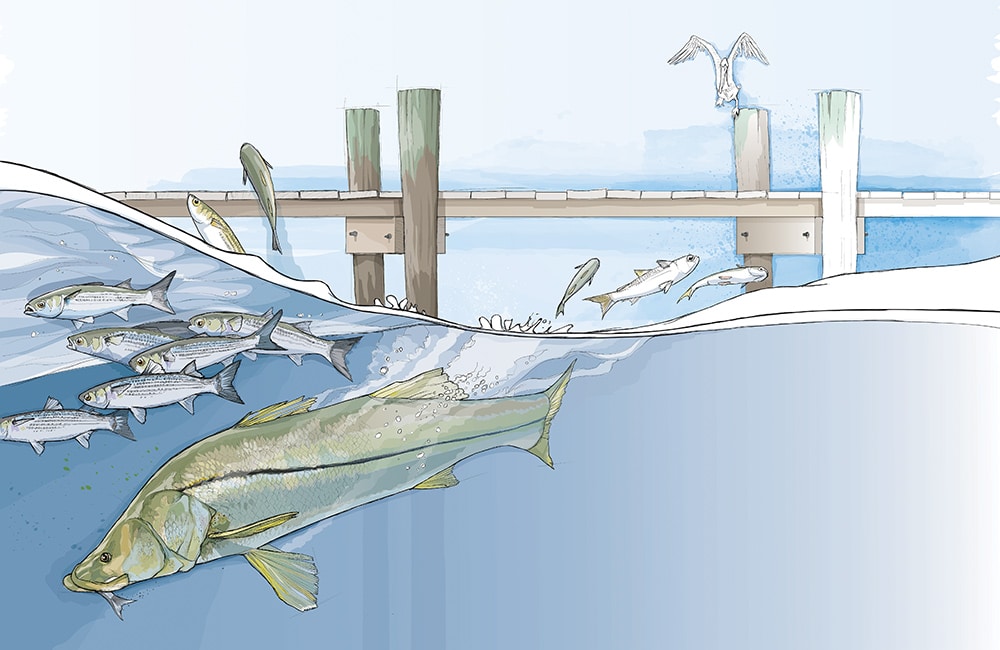
From snook to stripers and tripletail to tautog, many predators share some habits, first and foremost being the tendency to find just the right place to wait in ambush. That usually involves structure, and in the case of inshore game fish, structure means rocks, shoals, sod banks, pilings, bridge abutments, and any other submerged object that offers cover and holds baitfish, crustaceans, sea worms or other forage to prey upon. Here’s how to dissect the pieces of submarine real estate that popular species gravitate toward along the East Coast.
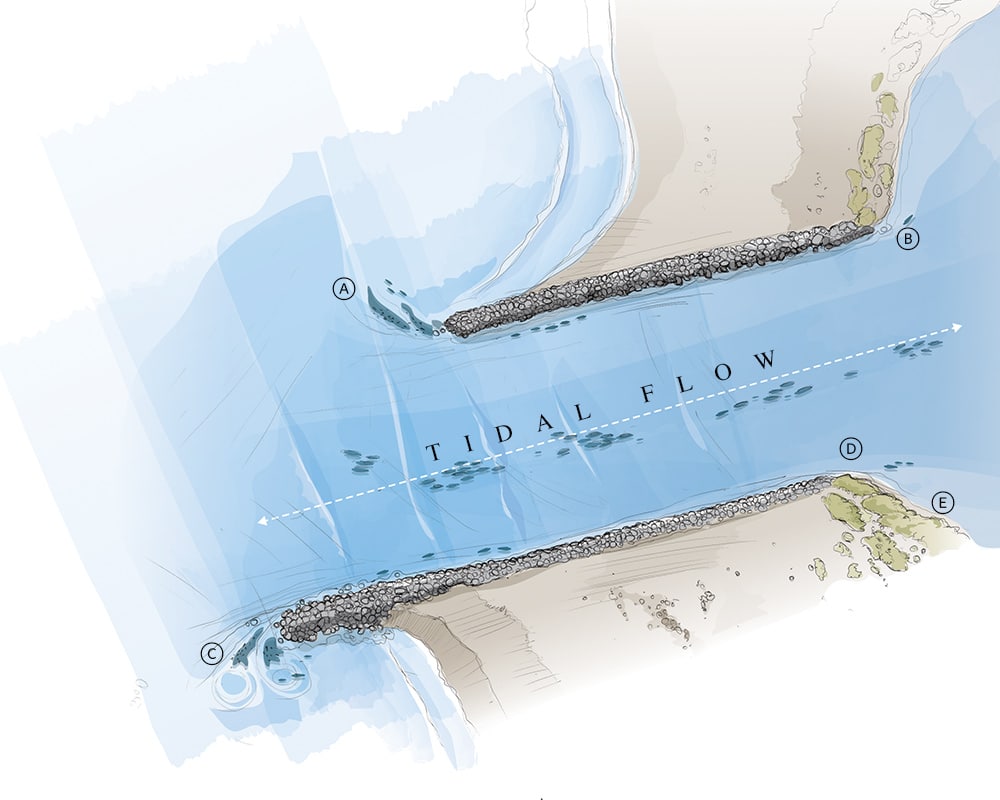
Inlets and Jetties
Rocks and jacks that line inlet jetties are a sure bet during shifting tides. The fluctuation of currents funnel both baitfish and predatory fish through the narrow inlet opening. During incoming tides, predatory fish such as snook, redfish, sharks and striped bass follow the push of the rising water to enter back bays. During outgoing tides, the rocks at the tip of a jetty serve as staging points for game fish to intercept baitfish schools that get caught in swirling eddies in the pocket pools. The “spin cycle” wrapping around the tips of jetty rocks provides optimal conditions for ambushing disoriented prey. Slack tide, when waters are still, is a primo time to target bottom brawlers, because crustaceans have nowhere to run. The more static species, like blackfish, sheepshead and snapper, root closer to the bottom along jetty rocks and submerged boulders to feed on crabs and shrimp crawling in the crags.
Read Next: Fishing Hard Edges
Spring tides, during new- and full-moon cycles, are especially productive around inlet jetties for all species. Live baits such as pilchards or eels cast off the jetty tips garner hits from tarpon and stripers, while bottom-bouncing with green crabs or shrimp cast outside fallen rocks warrants bites from blackfish and sheepshead.
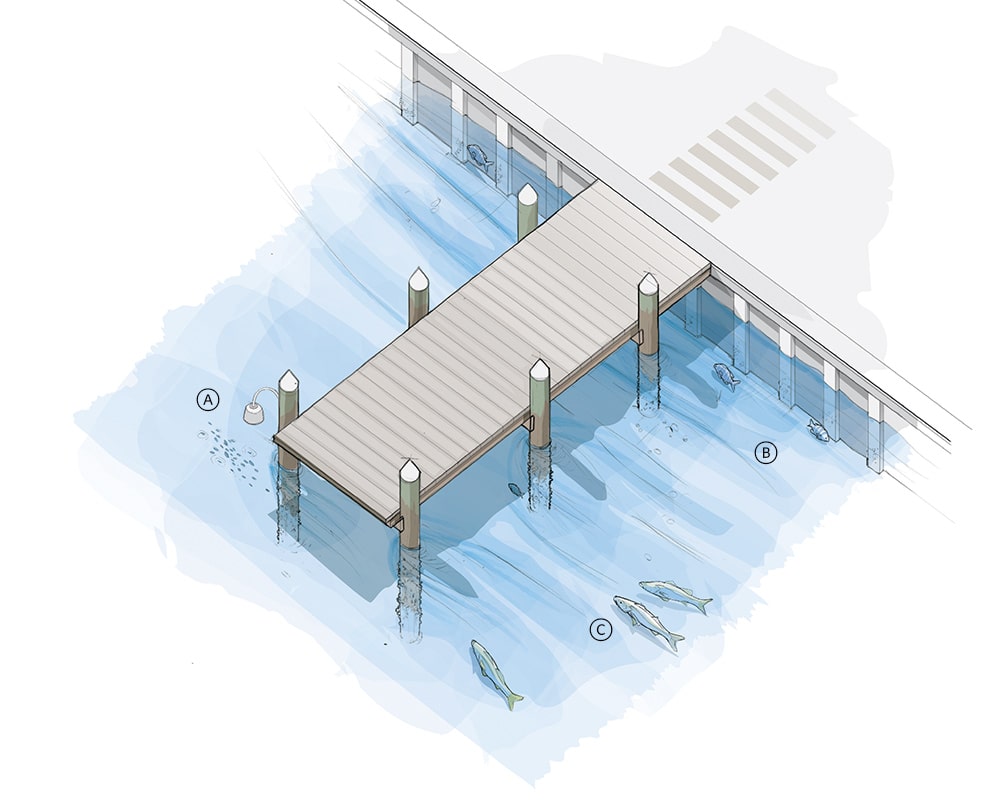
Docks and Bulkheads
Dock pilings and bulkheads often host a vertical food chain. Barnacles, mussels, crabs and shrimp stick to the pilings, attracting sheepshead and tautog. Pilings topped with a roof of planks also provide cover for game fish intent on ambushing prey. At night, shrimp, pilchards and other baitfish are attracted to the lights illuminating the docks, serving up easy meals to snook, seatrout and striped bass, which usually hang out on the downtide sides of dock pilings, and periodically dart out of the shadows to grab confused prey caught in the swirling eddies created by the structure.
Target docks, especially during flood tides around new and full moons, when forage gets washed off the surrounding sod banks and cord grasses, and funneled toward the inlet. The beauty of fishing backwater docks is that tidal flow usually takes place later the farther back into the bay or river system you go. So you can literally fish miles of dock pilings at the perfect stage of the tide, if you know how the timing sets up. Skipping soft-plastic baits like D.O.A. shrimp under the docks is sure to get you into a snook lair, while dropping a 3⁄8-ounce bucktail or Storm WildEye Swim Shad between pilings is bound to tempt any striped bass looking for an easy meal.
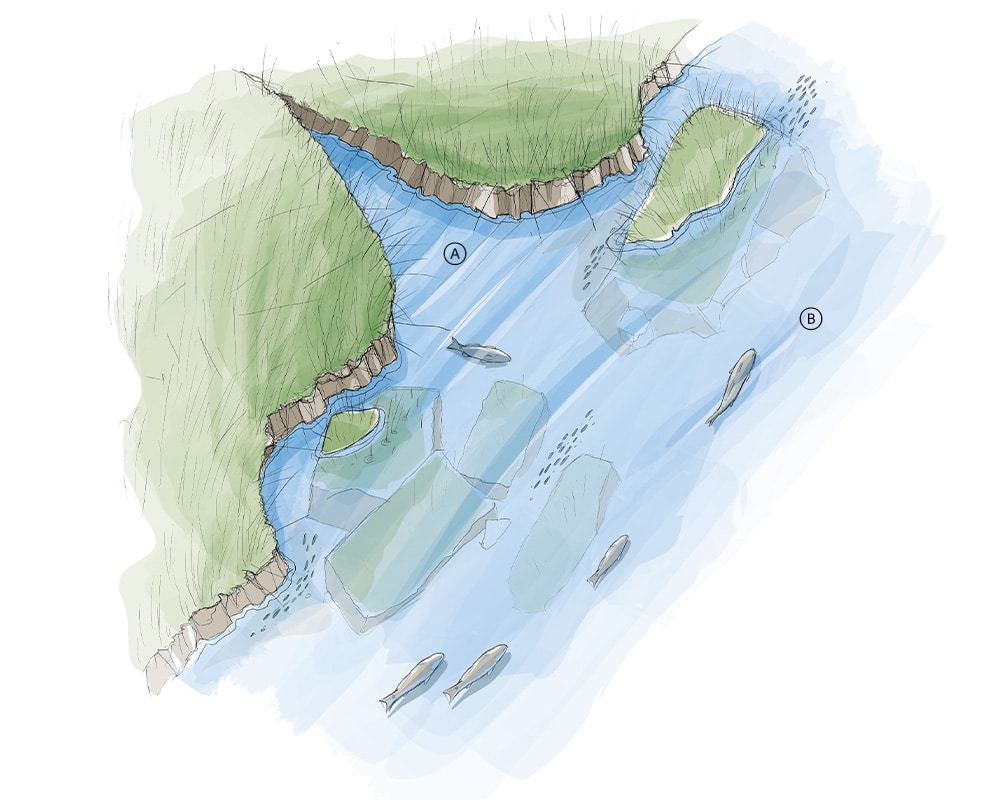
Submerged Sod Banks
Sometimes it’s not what you can see but what you can’t that gives you the edge. Look underwater, using the side-scan sonar to reveal submerged sod banks that have sloughed from back-bay marshes into the channel. Sea worms, clams and crabs root themselves in such muddy marshes, drawing in redfish, blackfish and black drum intent on rooting them out.
When an outgoing tide starts moving, bottom feeders have a virtual buffet line of forage funneling down off the mud banks. Mimic the bait washing off the banks, which in essence is crabs or sea worms, with lures that sport an appropriate profile, or work topwater poppers, spinnerbaits or soft-plastic baits on light jig heads over underwater fallen sod. Banks are continually falling into the water, creating underwater playgrounds — sometimes spanning up to 20 or 30 feet in length — that fish stick to time and time again.
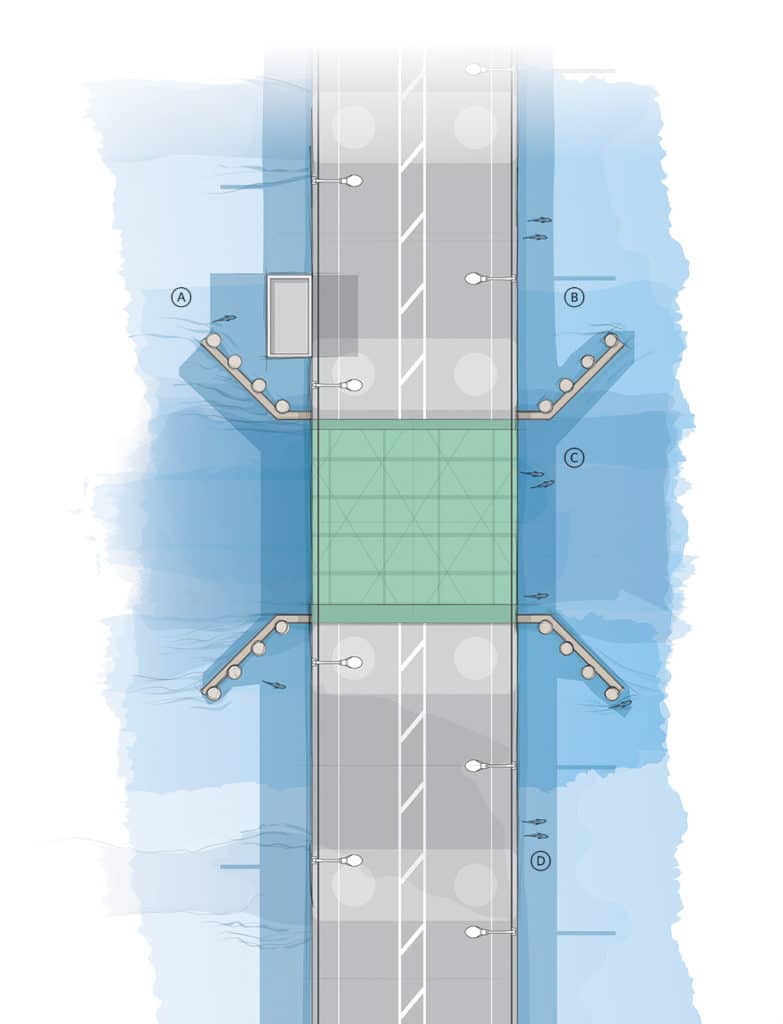
Bridges
Call it home-field advantage, but resident species from snook to tarpon and stripers always return to the same spots at the bridges they frequent. Concrete stanchions and columns will always be productive, no matter what species you target, because fish set up shop around them year-round. Bridge footings hold marine growth that some fish feed on, and most bridges have streetlamps that illuminate the area and also create shadow lines where other game hides, ready to pounce on the first baitfish or crustacean that comes near.
Practically any live bait or soft-plastic imitation worked in, out and along the shadow line inevitably gets whacked. Because bridges never move and rarely change much over time, you can bet on species like striped bass, snook and tarpon repeatedly feeding at the same tidal stages.
Live mullet and pilchards attract tarpon, while menhaden and eels can be drifted through bridges and around the stanchions for stripers.
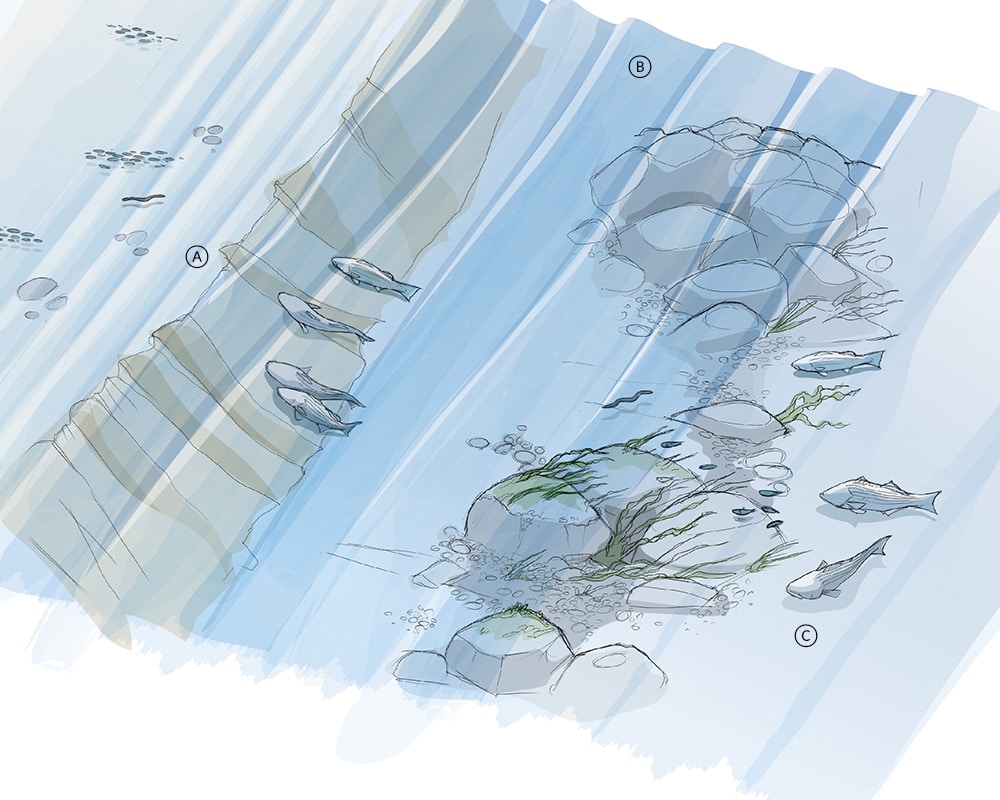
Ledges and Shoals
White water in an otherwise flat expanse of ocean is a telltale sign of structure below. Visible rips betray the presence of submerged ledges, shoals, humps and bumps that create the turbulent water.
In Delaware Bay, New Jersey, the Cape May Rips showcase a bottom contour that plummets from 3 feet deep to 30 in a short 50-yard stretch. Plum Gut off Long Island is a similar example. Striped bass stage on the down-current side of the drop-off, waiting in ambush to pick off eels, spot, croakers and bunker pushed in or out with the ripping tides.
Read Next: Fishing Mid-Atlantic Canyons
Submarine contour changes create swirling rips that disorient baitfish, so predators lurk on the back of the drop-offs, inhaling bait that funnels over with the tide. Whatever live bait you choose, be sure to fish it on or near the bottom with the help of the appropriate sinker; that’s where fish sit and wait for the next feeding opportunity, typically behind a structure or bottom feature that prevents them from having to constantly struggle against the brunt of the current.
When bottom structure creates surface disturbance that gives it away, the surface features will appear somewhat down-current of the actual bottom feature. Cast upstream of the rips to maximize your odds of the bait or lure reaching the fish at the proper depth.
Study Hard
While many structures are immovable, the tides, wind and current often combine to create foraging opportunities for game fish.
Learn to recognize the likely feeding stations that prevail with different variables, study the conditions upon your arrival to a spot, and you’ll be able to implement tactics that best suit the locale and situation.
Understanding structure dynamics and why they produce fish are the keys to vastly improving your rate of success as an angler.









